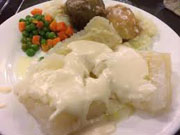Sharing is caring!
 Lutefisk is not well known outside of areas where there has been or is a large Scandinavian immigrant group. It has been a Christmas time tradition in northern Minnesota with many churches holding Lutefisk Dinners starting in the fall. Lutefisk starts out as salt cod. Salt cod has other names associated with it such as Baccala. Scandinavian fishermen would catch cod and preserve it by drying and salting it. The salt cod is turned into lutefisk by first soaking it in water and changing the water several times to remove the salt. After that is done, the salt cod is put into a solution of lye, technically a strong base solution. The immigrants typically used water that had been passed through wood ashes to extract the lye. This changes the chemical composition of the fish. I am heard it referred to by chemists as hydrolyzing the proteins. To use the lutefisk, it is washed several times in water to remove all traces of the lye. The old method of cooking lutefisk was by boiling it. This method produces a strong odor most people will never forget. It’s very much like making corned beef and cabbage by boiling.
Lutefisk is not well known outside of areas where there has been or is a large Scandinavian immigrant group. It has been a Christmas time tradition in northern Minnesota with many churches holding Lutefisk Dinners starting in the fall. Lutefisk starts out as salt cod. Salt cod has other names associated with it such as Baccala. Scandinavian fishermen would catch cod and preserve it by drying and salting it. The salt cod is turned into lutefisk by first soaking it in water and changing the water several times to remove the salt. After that is done, the salt cod is put into a solution of lye, technically a strong base solution. The immigrants typically used water that had been passed through wood ashes to extract the lye. This changes the chemical composition of the fish. I am heard it referred to by chemists as hydrolyzing the proteins. To use the lutefisk, it is washed several times in water to remove all traces of the lye. The old method of cooking lutefisk was by boiling it. This method produces a strong odor most people will never forget. It’s very much like making corned beef and cabbage by boiling.
I prefer using the microwave. There is very little cooking odor. The lutefisk falls apart and looks almost like pieces of clear Jell-O when done. This year I made a white sauce by using 1/4 stick butter and almost full cup of flour and making a roux. I wanted to make sure the butter was slightly cooked but did not want it to go brown like most rouxs. I then stirred in milk and kept stirring until the mixture thickened. I lastly added the microwaved lutefisk which I had broken up into small pieces with a couple of forks. I served that mixture over mashed potatoes and traditionally it would be served with green peas. More often than not the peas would be mashed as well. Merry Christmas and happy holidays.
